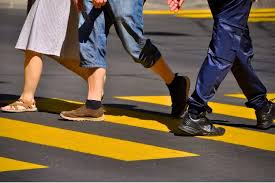Chicago is a vibrant, bustling city, home to millions of residents and visitors navigating its streets daily. With such high foot traffic, pedestrian safety is a critical concern. Understanding right-of-way laws is essential for both drivers and pedestrians to prevent accidents and ensure that everyone can move safely through the city. These laws are designed to protect pedestrians, who are often the most vulnerable road users.
Pedestrian accidents in Chicago remain a significant issue, with many incidents resulting from misunderstandings or disregard for right-of-way laws. Whether you’re a local or just visiting, knowing these laws can help you stay safe and avoid legal trouble.
The Basics of Pedestrian Right-of-Way in Chicago
In Chicago, pedestrians generally have the right-of-way at crosswalks, whether marked or unmarked. Drivers are required by law to yield to pedestrians crossing the street at these locations. This means that if a pedestrian is already in the crosswalk, vehicles must slow down or stop to allow them to cross safely. This law applies at both intersections and mid-block crosswalks, emphasizing the need for drivers to be vigilant.
However, pedestrians also have responsibilities. They must not suddenly leave a curb and walk or run into the path of a vehicle that is so close that it is impossible for the driver to yield. Understanding these basics helps ensure that both drivers and pedestrians can share the road safely, reducing the risk of accidents and enhancing overall traffic safety.
Unmarked Crosswalks: What Drivers and Pedestrians Should Know
Unmarked crosswalks are a common source of confusion in Chicago. These are areas where pedestrians have the right-of-way to cross the street, even though there are no painted lines or traffic signals indicating a crosswalk. These crossings typically exist at intersections where sidewalks continue across the street, even if the road is not clearly marked for pedestrian use.
For drivers, it’s crucial to recognize that unmarked crosswalks are present and to remain vigilant, ready to yield to pedestrians at intersections. Pedestrians should also stay cautious, ensuring that drivers notice them and slow down before stepping into the roadway. Being aware of these unmarked crosswalks and understanding their role can significantly reduce the risk of pedestrian accidents.
The Role of Traffic Signals and Signs in Pedestrian Right-of-Way
Traffic signals and signs play a crucial role in regulating pedestrian right-of-way in Chicago. At signalized intersections, pedestrians must obey the “Walk” and “Don’t Walk” signals. When the “Walk” signal is illuminated, pedestrians have the right-of-way, and vehicles must yield. However, when the “Don’t Walk” signal is flashing or steady, pedestrians should not enter the crosswalk, even if the light is green for vehicles.
Drivers must also pay attention to traffic signals and signs, particularly when making turns at intersections. Even if they have a green light, they must yield to pedestrians in the crosswalk. Disregarding these signals can lead to serious accidents and legal consequences. Both drivers and pedestrians must be aware of and follow these signals to maintain safety on the roads.
School Zones and Residential Areas: Special Considerations
In school zones and residential areas, pedestrian right-of-way laws are even more stringent. In Chicago, drivers are required to yield to pedestrians at all crosswalks within school zones when children are present, regardless of whether the crosswalk is marked. Speed limits are also reduced in these areas to enhance safety, and drivers must be extra cautious, especially during school hours.
Pedestrians, particularly children, may not always be aware of traffic rules, making it crucial for drivers to remain vigilant. In residential areas, where streets are narrower, and visibility might be reduced, the likelihood of encountering pedestrians is higher. Observing right-of-way laws and driving cautiously in these areas helps protect vulnerable pedestrians and prevent accidents.
The Consequences of Failing to Yield to Pedestrians
It is important for drivers in Chicago to remember that failing to yield to pedestrians can result in significant repercussions. Drivers who fail to adhere to pedestrian right-of-way laws may face substantial fines, increased insurance premiums, and potentially even criminal charges in the event of an accident. The legal consequences become even more severe if the failure to yield leads to injury or death of a pedestrian.
On the other hand, the impact of a driver’s failure to yield to pedestrians can be devastating. Pedestrian-involved traffic accidents in Chicago frequently lead to severe injuries or fatalities due to the lack of protection pedestrians have in comparison to motorists. Recognizing both the legal and personal ramifications emphasizes the vital importance of following right-of-way laws, not only to prevent legal issues but also to safeguard lives.
How Pedestrian Right-of-Way Laws Affect Legal Claims
In the aftermath of a pedestrian accident, determining who had the right-of-way is often a key factor in legal claims. If a driver fails to yield to a pedestrian who had the right-of-way, they are typically considered at fault for the accident. This can lead to a pedestrian filing a personal injury claim to recover damages for medical expenses, lost wages, and pain and suffering.
Conversely, if a pedestrian is found to have violated right-of-way rules, such as crossing against a signal, their ability to claim damages may be reduced or denied. This highlights the importance of understanding and following right-of-way laws for both pedestrians and drivers. Consulting with an experienced attorney who specializes in pedestrian injury cases can help navigate the complexities of such legal situations.
Tips for Pedestrians and Drivers
Both pedestrians and drivers have a role to play in maintaining safety on Chicago’s busy streets. Pedestrians should always use designated crosswalks, obey traffic signals, and make eye contact with drivers before crossing the street. Wearing bright or reflective clothing at night can also increase visibility and reduce the risk of accidents.
Drivers, on the other hand, should always be on the lookout for pedestrians, especially in busy downtown areas, near schools, and at intersections. Slowing down, particularly in areas with high foot traffic, and being prepared to stop at crosswalks can make a significant difference in preventing accidents.




